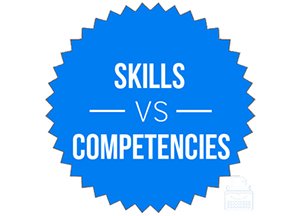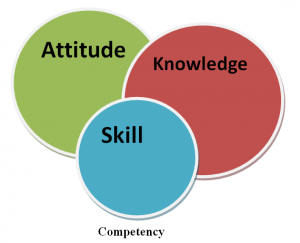
On our journey towards finding the distinction between HR terminology used interchangeably (Last blog post was on Recruitment vs Talent Aquisition ) has brought us to a new destination! We have arrived at another argument ie. Skills VS Competencies. There is a common misconception that these 2 are synonyms. In fact most HR’s categorize competencies as “Behavioural Traits” but this is not really the case. Let us understand the distinction first.


Definition
Skills: Skills is the ability or proficiency developed from one’s knowledge, practice, training, experience or aptitude. It is learned capacity that will help carry out many functions of a particular job
Competencies: It is the cluster of skill, ability, knowledge and attitude that enable a person to act effectively in any given job or situation leading to superior performance. It specifies what is needed by a person to perform a particular role/job in an organization successfully.
By their definitions we understand that skills tell us what type of abilities are required to be qualified to perform a particular job. But competencies tell us how a person can perform a job given the skills that he/she has. Competencies give us the big picture!
Why use Competencies?
Consistency: Today people with experience in IT have worked on many different technologies entailing many different skills. Consistency is a key indicator to make us aware how competent he is in using that skill. Job descriptions created will have pulled skill-sets from many different sources as a result they lack consistency.
Structure: An organization is built on competencies that help in designing and structuring of different departments, teams and other business units
Progression: Designing multi-level competencies means defining a specific skill at different levels of proficiency and expertise at different rungs of the corporate ladder. Understanding each of these proficiency levels is pivotal for employees to take control of their career advancement
Co-ordination: A subset of the competencies called “Core Competencies” is designed to articulate the key values shared and capabilities shared by all employees (entry-level to CEO) that form the organization’s competitive advantage in the market place.
Levels of Criticality!
In the previous section, we defined core competencies. There are other subsets of competencies that are critical and perhaps more important than most other competencies for every organization. These always fall under the below 2 categories.
Key Competencies: Every role has a list of competencies that must be met by the person. It is the essential criteria every recruiter considers desirable in potential candidates. Candidates should possess these to meet the demands of that position.
Core Competencies: Is a list of competency that relates to the business of the organization and every employee must have them. These are the competencies without which the company will not be able to meet their strategic goals. The core competency helps drive the culture of the organization.
PiMARQ’s 2 cents
PiMARQ believes that to perform a job successfully an employee needs to possess the right blend of attitude, knowledge and on-the-job ability! At PiMARQ for recruitment activity performed at PiMARQ, the team analyses the requirements for the open position and defines a multi-level competency list of elements. The recruiters will look at all the tangible materials such as resume, tests, interviews and references to quantify and match against the competency list!
Everything can be understood better with an example.
Recruitment Team at PiMARQ is working an open Java Developer position for one of our clients.
Let me tell you the Skills vs Competency analysis performed.
Behavioural (or Life Skills) Competencies: problem-solving, communication, analytical ability, initiative, logical ability, responsibility, decision making, organization, trustworthiness, ethics, resilience, persistence, can-do attitude, adaptability etc.
Functional (or Technical) Competencies: All the skills listed in the JD for Java Developer ie. Java, Spring and Spring Boot; Maven/Gradle, Thymeleaf, Apache Flink, Kafka, etc.
Professional Competencies: business sense, professionalism, commitment, people management, negotiation, commercial awareness, leadership, dressing sense, time management, change management, teamwork (These allow for success in an organizational context)
Why aren’t all companies “competency” based?
It’s procrastinated: Many small and mid-sized firms push the task to another day! They all want a one-size fits all solution! PiMARQ helps these start-ups by working on their competency development end to end.
Skills are easier to define: Skills are black and white but competencies are grey and up for interpretation.
The market is not fluent on the language of competency: When you look for a job you see only skills, experience required and CTC, very few can identify the competencies HR’s are looking for.
Competencies are only for performance: When PiMARQ asked people about competencies it was shocking to see the attitude! People thought competencies are solely for performance reviews! How unfair is that!? Most of them recognized competencies to be on the ‘to-be-developed-in-6-months’ list outlined by the supervisor! This seems backward and unfair!
There is a bigger voice in this conversation that is yet to be discussed. The 21st century discussion on competencies is incomplete without mentioning the ongoing debate waged in schools and educational institutions on the role of competencies and its larger implications in the field of education.
PiMARQ works with educational institutions to help transitioning Students Bridge the gap between College to Corporate based on a competency solution. But perhaps that is a discussion for another day and not in the purview of this blog!

